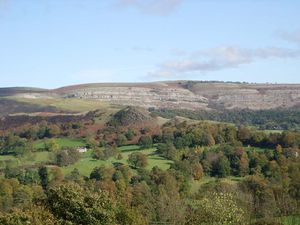Wales (Cymru) - North Wales Coalfield
The North Wales Coalfield is defined by a north—south trending surface exposure of Carboniferous Limestone, Millstone Grit and Coal Measures that extends from Deeside south through Wrexham to Oswestry. The geography is dominated by a prominent ridge of Carboniferous Limestone in the west and falls gently eastwards toward the low ground of the Cheshire Plain of the Central England region in a series of low ridges.

Sedimentary bedrock
The youngest sedimentary bedrock is the Coal Measures, comprising a thick, densely faulted sequence of alternating grey mudstones and sandstones with thin coal seams that together make up the formerly productive part of the North Wales Coalfield. These rocks formed from vast quantities of sediment being transported by large river deltas. Occasionally the tops of these deltas were exposed, which allowed massive swampy forests to develop. After burial the vegetation from these forests was compressed to produce layers of coal. The upper part of this sequence comprises red sandstone and mudstones without economic coal layers. The Coal Measures pass down into layers of sandstones and mudstone collectively known as the Millstone Grit. The lowest part of the succession comprises layers of Carboniferous Limestone (Plate P662426) that generally dip toward the east and extend under the rest of the area at depth. As well as exploitation of coal seams, the limestone is host to mineral deposits of lead that were widely mined in the past. More recent interest in the Coal Measures has focused on their potential as a resource for gas. As well as its mineral potential, the presence of significant fractures in the Carboniferous Limestone means that it is a locally important minor aquifer that represents a significant source of public water supply.
Basement rocks
These rocks underlie the whole area at great depth. They comprise strongly folded and faulted mudstones and sandstones like those exposed in the east of the north-west Wales area.